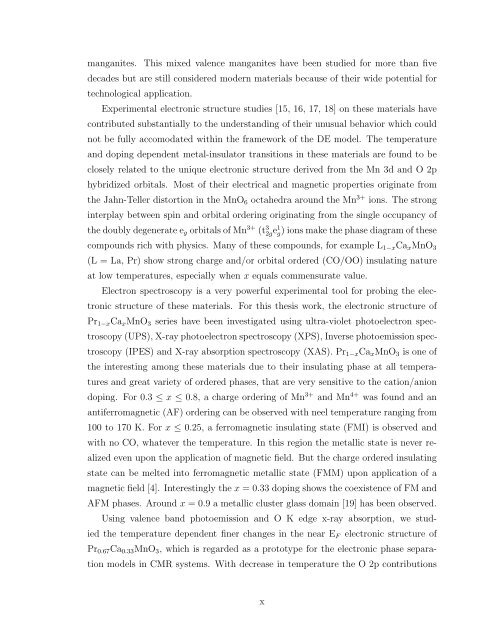PHYS07200604007 Manas Kumar Dala - Homi Bhabha National ...
PHYS07200604007 Manas Kumar Dala - Homi Bhabha National ...
PHYS07200604007 Manas Kumar Dala - Homi Bhabha National ...
You also want an ePaper? Increase the reach of your titles
YUMPU automatically turns print PDFs into web optimized ePapers that Google loves.
manganites. This mixed valence manganites have been studied for more than five<br />
decades but are still considered modern materials because of their wide potential for<br />
technological application.<br />
Experimental electronic structure studies [15, 16, 17, 18] on these materials have<br />
contributed substantially to the understanding of their unusual behavior which could<br />
not be fully accomodated within the framework of the DE model. The temperature<br />
and doping dependent metal-insulator transitions in these materials are found to be<br />
closely related to the unique electronic structure derived from the Mn 3d and O 2p<br />
hybridized orbitals. Most of their electrical and magnetic properties originate from<br />
the Jahn-Teller distortion in the MnO 6 octahedra around the Mn 3+ ions. The strong<br />
interplay between spin and orbital ordering originating from the single occupancy of<br />
the doubly degenerate e g orbitals of Mn 3+ (t 3 2ge 1 g) ions make the phase diagram of these<br />
compounds rich with physics. Many of these compounds, for example L 1−x Ca x MnO 3<br />
(L = La, Pr) show strong charge and/or orbital ordered (CO/OO) insulating nature<br />
at low temperatures, especially when x equals commensurate value.<br />
Electron spectroscopy is a very powerful experimental tool for probing the electronic<br />
structure of these materials. For this thesis work, the electronic structure of<br />
Pr 1−x Ca x MnO 3 series have been investigated using ultra-violet photoelectron spectroscopy<br />
(UPS), X-ray photoelectron spectroscopy (XPS), Inverse photoemission spectroscopy<br />
(IPES) and X-ray absorption spectroscopy (XAS). Pr 1−x Ca x MnO 3 is one of<br />
the interesting among these materials due to their insulating phase at all temperatures<br />
and great variety of ordered phases, that are very sensitive to the cation/anion<br />
doping. For 0.3 ≤ x ≤ 0.8, a charge ordering of Mn 3+ and Mn 4+ was found and an<br />
antiferromagnetic (AF) ordering can be observed with neel temperature ranging from<br />
100 to 170 K. For x ≤ 0.25, a ferromagnetic insulating state (FMI) is observed and<br />
with no CO, whatever the temperature. In this region the metallic state is never realized<br />
even upon the application of magnetic field. But the charge ordered insulating<br />
state can be melted into ferromagnetic metallic state (FMM) upon application of a<br />
magnetic field [4]. Interestingly the x = 0.33 doping shows the coexistence of FM and<br />
AFM phases. Around x = 0.9 a metallic cluster glass domain [19] has been observed.<br />
Using valence band photoemission and O K edge x-ray absorption, we studied<br />
the temperature dependent finer changes in the near E F electronic structure of<br />
Pr 0.67 Ca 0.33 MnO 3 , which is regarded as a prototype for the electronic phase separation<br />
models in CMR systems. With decrease in temperature the O 2p contributions<br />
x
















